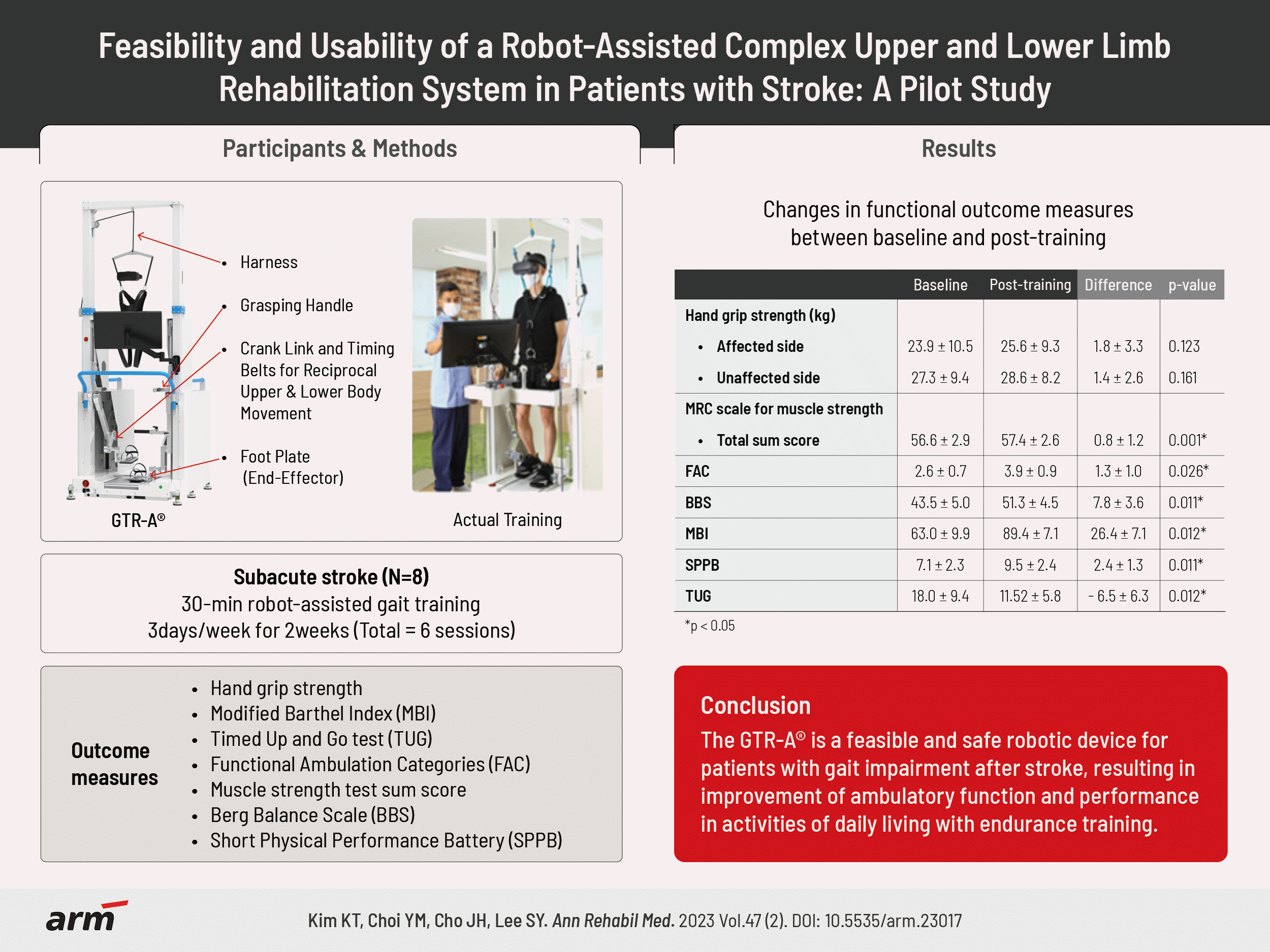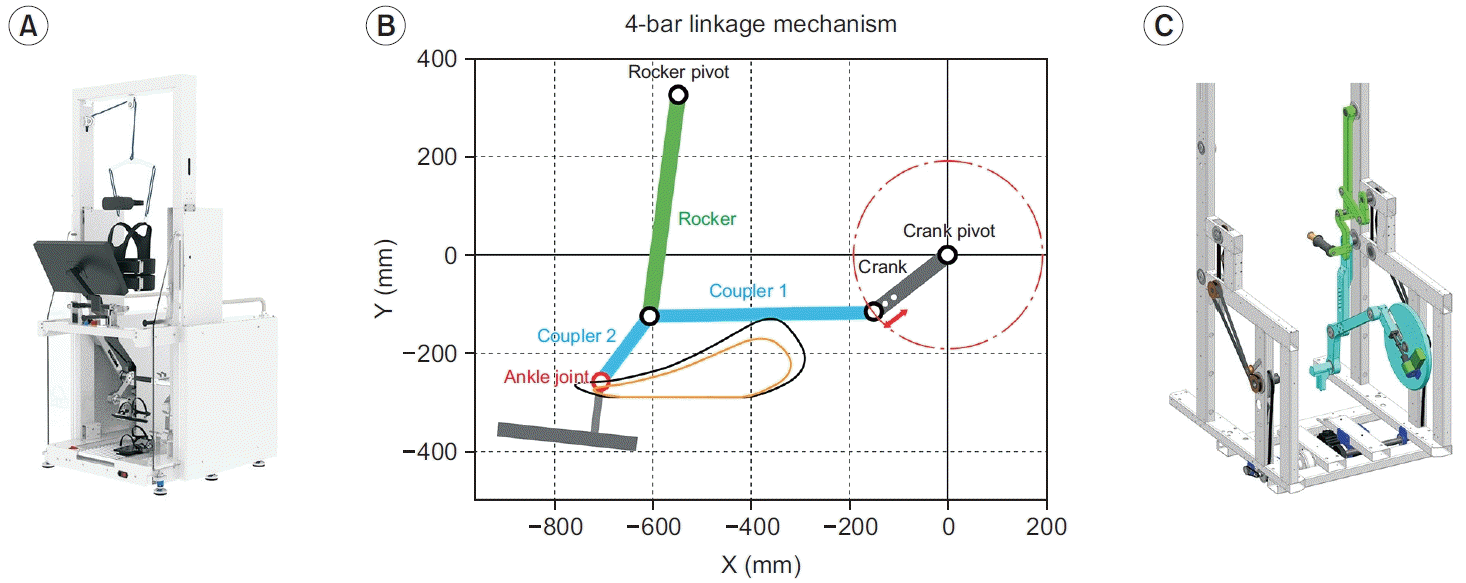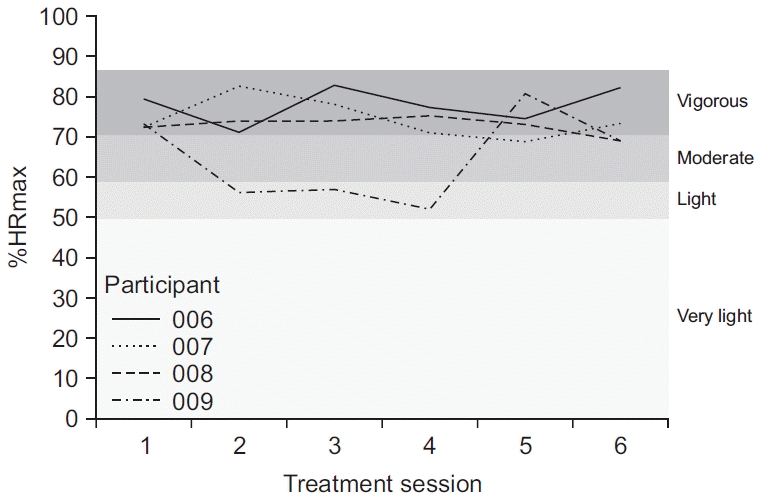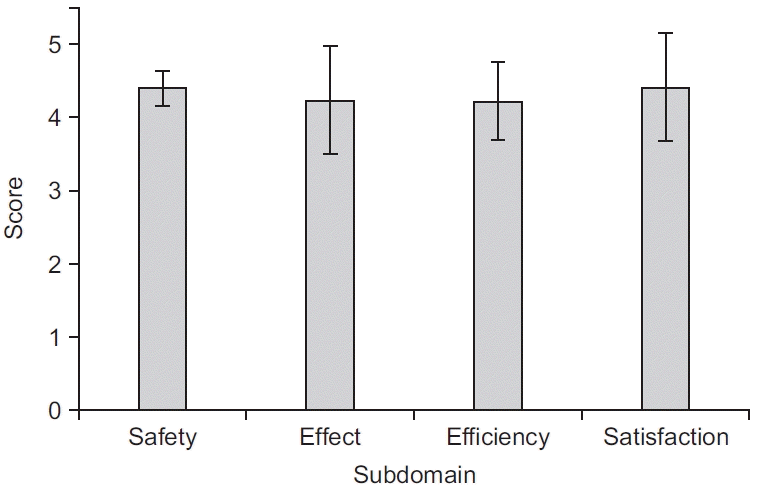1. Langhorne P, Coupar F, Pollock A. Motor recovery after stroke: a systematic review. Lancet Neurol. 2009; 8:741–54.

2. Laufer Y, Dickstein R, Chefez Y, Marcovitz E. The effect of treadmill training on the ambulation of stroke survivors in the early stages of rehabilitation: a randomized study. J Rehabil Res Dev. 2001; 38:69–78.
3. Jun HJ, Kim KJ, Chun IA, Moon OK. The relationship between stroke patients’ socio-economic conditions and their quality of life: the 2010 Korean community health survey. J Phys Ther Sci. 2015; 27:781–4.

4. French B, Thomas LH, Coupe J, McMahon NE, Connell L, Harrison J, et al. Repetitive task training for improving functional ability after stroke. Cochrane Database Syst Rev. 2016; 11:CD006073.

5. Moucheboeuf G, Griffier R, Gasq D, Glize B, Bouyer L, Dehail P, et al. Effects of robotic gait training after stroke: a meta-analysis. Ann Phys Rehabil Med. 2020; 63:518–34.

6. Eng JJ, Tang PF. Gait training strategies to optimize walking ability in people with stroke: a synthesis of the evidence. Expert Rev Neurother. 2007; 7:1417–36.

7. Page SJ, Levine P, Teepen J, Hartman EC. Resistancebased, reciprocal upper and lower limb locomotor training in chronic stroke: a randomized, controlled crossover study. Clin Rehabil. 2008; 22:610–7.

8. Oh K, Park J, Jo SH, Hong SJ, Kim WS, Paik NJ, et al. Improved cortical activity and reduced gait asymmetry during poststroke self-paced walking rehabilitation. J Neuroeng Rehabil. 2021; 18:60.

9. Hidler J, Nichols D, Pelliccio M, Brady K, Campbell DD, Kahn JH, et al. Multicenter randomized clinical trial evaluating the effectiveness of the Lokomat in subacute stroke. Neurorehabil Neural Repair. 2009; 23:5–13.

10. Hesse S, Waldner A, Tomelleri C. Innovative gait robot for the repetitive practice of floor walking and stair climbing up and down in stroke patients. J Neuroeng Rehabil. 2010; 7:30.

11. Su Y, Yuki M, Otsuki M. Prevalence of stroke-related sarcopenia: a systematic review and meta-analysis. J Stroke Cerebrovasc Dis. 2020; 29:105092.

12. van Nunen MP, Gerrits KH, de Haan A, Janssen TW. Exercise intensity of robot-assisted walking versus overground walking in nonambulatory stroke patients. J Rehabil Res Dev. 2012; 49:1537–46.

13. Sharif H, Gammage K, Chun S, Ditor D. Effects of FES-ambulation training on locomotor function and health-related quality of life in individuals with spinal cord injury. Top Spinal Cord Inj Rehabil. 2014; 20:58–69.

14. Siegle CBH, de Carvalho JKF, Utiyama DMO, Matheus D, Alfieri FM, Ayres DVM, et al. Effects of robotic intervention associated with conventional therapy on gait speed and resistance and trunk control in stroke patients. Acta Fisiátr. 2019; 26:127–9.

16. Faulkner L. Beyond the five-user assumption: benefits of increased sample sizes in usability testing. Behav Res Methods Instrum Comput. 2003; 35:379–83.

17. Seo JW, Kim HS. Biomechanical analysis in five bar linkage prototype machine of gait training and rehabilitation by IMU sensor and electromyography. Sensors (Basel). 2021; 21:1726.

18. Garber CE, Blissmer B, Deschenes MR, Franklin BA, Lamonte MJ, Lee IM, et al. American College of Sports Medicine position stand. Quantity and quality of exercise for developing and maintaining cardiorespiratory, musculoskeletal, and neuromotor fitness in apparently healthy adults: guidance for prescribing exercise. Med Sci Sports Exerc. 2011; 43:1334–59.
19. Kwon SH, Lee BS, Lee HJ, Kim EJ, Lee JA, Yang SP, et al. Energy efficiency and patient satisfaction of gait with knee-ankle-foot orthosis and robot (ReWalk)-assisted gait in patients with spinal cord injury. Ann Rehabil Med. 2020; 44:131–41.

20. Hermans G, Clerckx B, Vanhullebusch T, Segers J, Vanpee G, Robbeets C, et al. Interobserver agreement of Medical Research Council sum-score and handgrip strength in the intensive care unit. Muscle Nerve. 2012; 45:18–25.

21. Dietz V. Interaction between central programs and afferent input in the control of posture and locomotion. J Biomech. 1996; 29:841–4.

22. Kim JC, Lim JH. The effects of coordinative locomotor training on coordination and gait in chronic stroke patients: a randomized controlled pilot trial. J Exerc Rehabil. 2018; 14:1010–6.

23. Stephenson JL, Lamontagne A, De Serres SJ. The coordination of upper and lower limb movements during gait in healthy and stroke individuals. Gait Posture. 2009; 29:11–6.

24. Ford MP, Wagenaar RC, Newell KM. Phase manipulation and walking in stroke. J Neurol Phys Ther. 2007; 31:85–91.

25. Bovonsunthonchai S, Hiengkaew V, Vachalathiti R, Vongsirinavarat M, Tretriluxana J. Effect of speed on the upper and contralateral lower limb coordination during gait in individuals with stroke. Kaohsiung J Med Sci. 2012; 28:667–72.

26. Ford MP, Wagenaar RC, Newell KM. Arm constraint and walking in healthy adults. Gait Posture. 2007; 26:135–41.

27. Morone G, Paolucci S, Cherubini A, De Angelis D, Venturiero V, Coiro P, et al. Robot-assisted gait training for stroke patients: current state of the art and perspectives of robotics. Neuropsychiatr Dis Treat. 2017; 13:1303–11.

28. Morone G, Bragoni M, Iosa M, De Angelis D, Venturiero V, Coiro P, et al. Who may benefit from roboticassisted gait training? A randomized clinical trial in patients with subacute stroke. Neurorehabil Neural Repair. 2011; 25:636–44.
29. Peurala SH, Airaksinen O, Huuskonen P, Jäkälä P, Juhakoski M, Sandell K, et al. Effects of intensive therapy using gait trainer or floor walking exercises early after stroke. J Rehabil Med. 2009; 41:166–73.

30. Chang WH, Kim MS, Huh JP, Lee PK, Kim YH. Effects of robot-assisted gait training on cardiopulmonary fitness in subacute stroke patients: a randomized controlled study. Neurorehabil Neural Repair. 2012; 26:318–24.

31. Baronchelli F, Zucchella C, Serrao M, Intiso D, Bartolo M. The effect of robotic assisted gait training with Lokomat ® on balance control after stroke: systematic review and meta-analysis. Front Neurol. 2021; 12:661815.
32. Hornby TG, Straube DS, Kinnaird CR, Holleran CL, Echauz AJ, Rodriguez KS, et al. Importance of specificity, amount, and intensity of locomotor training to improve ambulatory function in patients poststroke. Top Stroke Rehabil. 2011; 18:293–307.

33. Molteni F, Gasperini G, Cannaviello G, Guanziroli E. Exoskeleton and end-effector robots for upper and lower limbs rehabilitation: narrative review. PM R. 2018; 10(9 Suppl 2):S174–88.

34. Iosa M, Morone G, Bragoni M, De Angelis D, Venturiero V, Coiro P, et al. Driving electromechanically assisted Gait Trainer for people with stroke. J Rehabil Res Dev. 2011; 48:135–46.

35. Stoller O, de Bruin ED, Schindelholz M, Schuster-Amft C, de Bie RA, Hunt KJ. Efficacy of feedback-controlled robotics-assisted treadmill exercise to improve cardiovascular fitness early after stroke: a randomized controlled pilot trial. J Neurol Phys Ther. 2015; 39:156–65.
36. Luo L, Meng H, Wang Z, Zhu S, Yuan S, Wang Y, et al. Effect of high-intensity exercise on cardiorespiratory fitness in stroke survivors: a systematic review and meta-analysis. Ann Phys Rehabil Med. 2020; 63:59–68.

37. Bessler J, Prange-Lasonder GB, Schulte RV, Schaake L, Prinsen EC, Buurke JH. Occurrence and type of adverse events during the use of stationary gait robotsa systematic literature review. Front Robot AI. 2020; 7:557606.

38. Chin LF, Lim WS, Kong KH. Evaluation of robotic-assisted locomotor training outcomes at a rehabilitation centre in Singapore. Singapore Med J. 2010; 51:709–15. Erratum in: Singapore Med J 2010;51:840.
39. Mao X, Yamada Y, Akiyama Y, Okamoto S, Yoshida K. Development of a novel test method for skin safety verification of physical assistant robots. Paper presented at: 2015 IEEE International Conference on Rehabilitation Robotics (ICORR); 2015 Aug 11-14; Singapore, Singapore.
40. Akiyama Y, Yamada Y, Ito K, Oda S, Okamoto S, Hara S. Test method for contact safety assessment of a wearable robot -analysis of load caused by a misalignment of the knee joint-. Paper presented at: 2012 IEEE ROMAN: The 21st IEEE International Symposium on Robot and Human Interactive Communication; 2012 Sep 9-13; Paris, France.




 PDF
PDF Citation
Citation Print
Print







 XML Download
XML Download